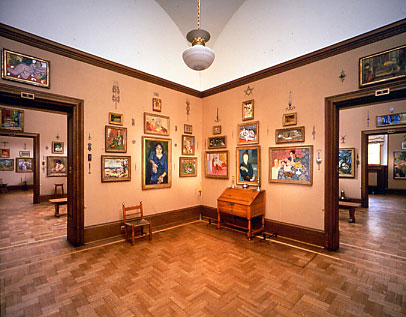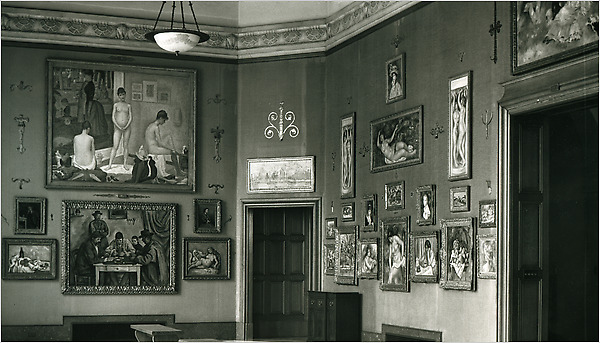Who Owns Art? - Not Looking At The Barnes Collection
What do you own when you buy a work of art?
You own the material art work of course, the painting, but do you also own the image?
Do you buy the right to withhold that image from the public view forever?
The Barnes Collection:
From WIkipedia:
Albert C. Barnes, was a man who beginning in 1912, collected art after making a fortune by co-developing an early antiseptic drug marketed as Argyrol.
Today, his Foundation possesses more than 2500 objects, including 800 paintings estimated to be worth about $25 billion.
Among its collection are 181 works by Pierre-Auguste Renoir, 69 by Paul Cézanne, 59 by Henri Matisse, 46 by Pablo Picasso, 21 by Chaim Soutine, 18 by Henri Rousseau, 16 by Amedeo Modigliani, 11 by Edgar Degas, 7 by Vincent Van Gogh, 6 by Georges Seurat, as well as numerous other masters, including Giorgio de Chirico, Paul Gauguin, El Greco, Francisco Goya, Edouard Manet, Claude Monet, Maurice Utrillo.
This is a very great number of modernist masterpieces. A substantial percentage of our entire world heritage of them.
What Barnes did:
Because of the intransigence of Barnes, this man who sold a skin antiseptic and bought art extremely cheaply in Paris from desperate artists, all of these works of art have been effectively withheld from the public view for almost a century.
Barnes set up a school foundation in the suburbs of Philadelphia, but because of its size and location, and the fact that its primary function was as a private art school, and not a museum, it could only be visited by appointment, and very few people have ever been able to go there.
For almost 70 years Barnes' will stipulated that the collection could only be opened to the public at all for not more than 2 days per week. As a result most Philadelphians have never seen the collection, far less most global art lovers.
I have no idea who Barnes' art students were, but none of them ever became artists of note. In photographs they appear to be housewives taking art classes.
The Barnes Collection is the preeminent world collection of modern art, which can never be loaned to other museums and only be displayed complete and in the manner prescribed by Barnes. This is the style of the Paris salon display, which Barnes witnessed at his friend Gertrude Stein's house.
This style of exhibition most resembles a thrift store painting display rather than a contemporary gallery exhibition. (You can see some photos of it below). Displaying these recognized masterpieces in this cramped and undignified manner shows little understanding or respect for the works.
Because of one man, $25 billion of art masterpieces have been trapped in a Philadelphia suburb for most of the 20th century, unseen and unenjoyed by the entire world.
Obviously this is a madness, but more than this, it is something which should be illegal. No work of art should be allowed to remain in private hands in perpetuity. And certainly not unseen in private hands. Art is not made to be hoarded by rich misers.
Currently the City of Philadelphia is engaged in breaking the Barnes will, which has been watertight for decades. Barnes himself is long dead, as are his proselytes.
Nevertheless the City of Philadelphia is determined that the paintings never leave that city. Instead they are to be used to lure tourists who would otherwise see little reason to go.
The sixteen Modigliani paintings they have in the Barnes Collection form a substantial proportion of Modigliani's surviving works. This constitutes perhaps 15% of Modigliani's cultural heritage, which means effectively of Modigliani himself. And Modigliani who was starving was forced to sell his paintings for $20 or less.
Barnes did not have to sell a lot of antiseptic cream to amass this cultural treasure. What he did was more or less loot the modern French Art of Paris, paying only a pittance to do it.
These paintings were taken hostage for almost a century by the ego of one rich man. The sensibility of the world has now moved beyond this kind of aristocratic right. It must never be allowed to happen again not by an individual or a corporation or even an institution. Not least a local council of a provincial city.
Art belongs to the public, all of art belongs to all of the public. A collector may rent it from the artist for a period of time, but she may not own it and withhold it.
It is the artist who created it for the world who should have the final say in how it is permanently given to the world.
Not only should the Barnes Collection be opened to the world - it should never have been allowed to have been hoarded and it should now be moved not only from its suburban estate, but completely out of the city of Philadelphia and into a major art city of the world which is more easily accessible to all, such as New York, London or particularly Paris, where all of the art was created and looted by Barnes in the first place.
It is an obscenity that this has been allowed to happen at all.
Now thanks to Philadelphia local political machinations, this unsurpassed treasure trove of modern art has fallen into the hands of the city council of a provincial city. Which is a barely better fate than its past fate has been.
The French government should demand that the Barnes will be rendered illegal by the US Congress, and the works of art returned into the world cultural heritage. And the US Congress should willingly comply.
There is no argument that can justify the need for such a substantial proportion of world modern art masterpieces to reside in a provincial city, whether in a suburb of that city or not.
A dead man has no need to control $25 billion of important art works simply to satisfy his ego. Nor does a city council comprised of people with no interest in art except as an local tourist attraction.
These paintings belong in the world where art lovers can see them.
Here are photographs taken inside the Barnes Museum. The arrangement of the exhibition space is a disgrace and an insult to the paintings. The City of Philadelphia intends to continue to display them in this manner as a deference to the will of Barnes.




